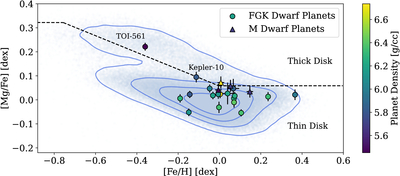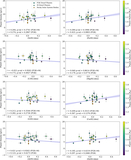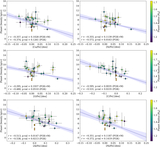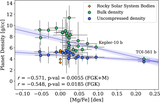Image Details

Caption: Figure 2.
[Mg/Fe] vs. [Fe/H] for stars that host our rocky planet sample, as well as all main-sequence dwarfs in SDSS-V with reliable abundances. The SDSS-V dwarfs are plotted in the background as transparent blue dots, while the FGK and M dwarfs that host our rocky planet sample are marked as circles and triangles, respectively, and are colored by the densities of their rocky planets. The blue contours trace the background star 10% density distribution levels, and the dashed black line delineates the thin–thick disk separation (M. Franchini et al. 2020). TOI-561 and Kepler-10 are highlighted as high-confidence and possible thick disk stars, respectively.
Copyright and Terms & Conditions
© 2025. The Author(s). Published by the American Astronomical Society.








